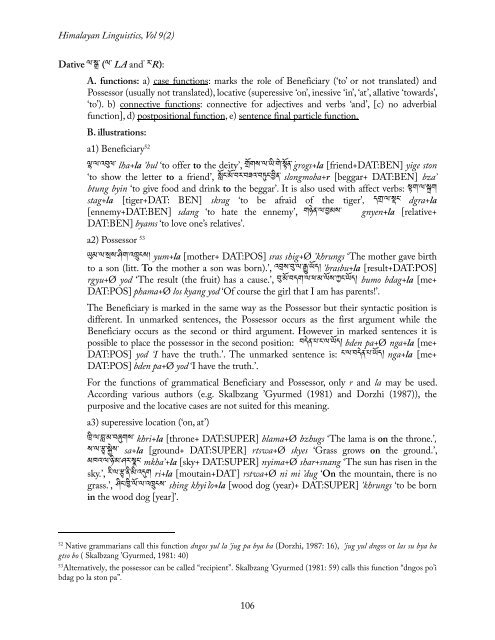The Classical Tibetan cases and their transcategoriality
The Classical Tibetan cases and their transcategoriality
The Classical Tibetan cases and their transcategoriality
Create successful ePaper yourself
Turn your PDF publications into a flip-book with our unique Google optimized e-Paper software.
Himalayan Linguistics, Vol 9(2)<br />
Dative ལ་སྒྲ་ (ལ་ LA <strong>and</strong>་ ར་R):<br />
A. functions: a) case functions: marks the role of Beneficiary (‘to’ or not translated) <strong>and</strong><br />
Possessor (usually not translated), locative (superessive ‘on’, inessive ‘in’, ‘at’, allative ‘towards’,<br />
‘to’). b) connective functions: connective for adjectives <strong>and</strong> verbs ‘<strong>and</strong>’, [c) no adverbial<br />
function], d) postpositional function, e) sentence final particle function.<br />
B. illustrations:<br />
a1) Beneficiary52 ལྷ་ལ་འབུལ་ lha+la ’bul ‘to offer to the deity’, གྲོགས་ལ་ཡི་གེ་སྟོན་་grogs+la [friend+DAT:BEN] yige ston<br />
‘to show the letter to a friend’, སློང་མོ་བར་བཟའ་བཏུང་བྱིན་ slongmoba+r [beggar+ DAT:BEN] bza’<br />
btung byin ‘to give food <strong>and</strong> drink to the beggar’. It is also used with affect verbs: སྟག་ལ་སྐྲག<br />
stag+la [tiger+DAT: BEN] skrag ‘to be afraid of the tiger’, དགྲ་ལ་སྡང་ dgra+la<br />
[ennemy+DAT:BEN] sdang ‘to hate the ennemy’, གཉེན་ལ་བྱམས་ gnyen+la [relative+<br />
DAT:BEN] byams ‘to love one’s relatives’.<br />
a2) Possessor 53<br />
ཡུམ་ལ་སྲས་ཤིག་འཁྲུངས། yum+la [mother+ DAT:POS] sras shig+Ø ’khrungs ‘<strong>The</strong> mother gave birth<br />
to a son (litt. To the mother a son was born).’, འབྲས་བུ་ལ་རྒྱུ་ཡོད། ’brasbu+la [result+DAT:POS]<br />
rgyu+Ø yod ‘<strong>The</strong> result (the fruit) has a cause.’, བུ་མོ་བདག་ལ་ཕ་མ་ལོས་ཀྱང་ཡོད། bumo bdag+la [me+<br />
DAT:POS] phama+Ø los kyang yod ‘Of course the girl that I am has parents!’.<br />
<strong>The</strong> Beneficiary is marked in the same way as the Possessor but <strong>their</strong> syntactic position is<br />
different. In unmarked sentences, the Possessor occurs as the first argument while the<br />
Beneficiary occurs as the second or third argument. However in marked sentences it is<br />
possible to place the possessor in the second position: བདེན་པ་ང་ལ་ཡོད། bden pa+Ø nga+la [me+<br />
DAT:POS] yod ‘I have the truth.’. <strong>The</strong> unmarked sentence is: ང་ལ་བདེན་པ་ཡོད། nga+la [me+<br />
DAT:POS] bden pa+Ø yod ‘I have the truth.’.<br />
For the functions of grammatical Beneficiary <strong>and</strong> Possessor, only r <strong>and</strong> la may be used.<br />
According various authors (e.g. Skalbzang ’Gyurmed (1981) <strong>and</strong> Dorzhi (1987)), the<br />
purposive <strong>and</strong> the locative <strong>cases</strong> are not suited for this meaning.<br />
a3) superessive location (‘on, at’)<br />
ཁྲི་ལ་བླ་མ་བཞུགས་ khri+la [throne+ DAT:SUPER] blama+Ø bzhugs ‘<strong>The</strong> lama is on the throne.’,<br />
ས་ལ་རྩྭ་སྐྱེས་ sa+la [ground+ DAT:SUPER] rtswa+Ø skyes ‘Grass grows on the ground.’,<br />
མཁའ་ལ་ཉི་མ་ཤར་སྣང་ mkha’+la [sky+ DAT:SUPER] nyima+Ø shar+snang ‘<strong>The</strong> sun has risen in the<br />
sky.’, རི་ལ་རྩྭ་ནི་མི་འདུག ri+la [moutain+DAT] rstwa+Ø ni mi ’dug ‘On the mountain, there is no<br />
grass.’, ཤིང་ཁྱི་ལོ་ལ་འཁྲུངས་ shing khyi་lo+la [wood dog (year)+ DAT:SUPER] ’khrungs ‘to be born<br />
in the wood dog [year]’.<br />
52 Native grammarians call this function dngos yul la ’jug pa bya ba (Dorzhi, 1987: 16), ’jug yul dngos or las su bya ba<br />
gtso bo ( Skalbzang ’Gyurmed, 1981: 40)<br />
53Alternatively, the possessor can be called “recipient”. Skalbzang ’Gyurmed (1981: 59) calls this function “dngos po’i<br />
bdag po la ston pa”.<br />
106
















